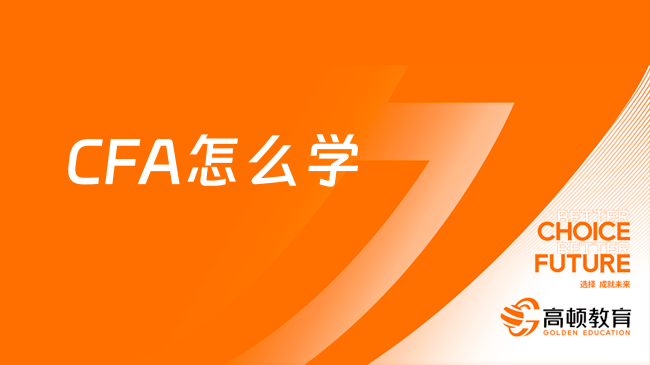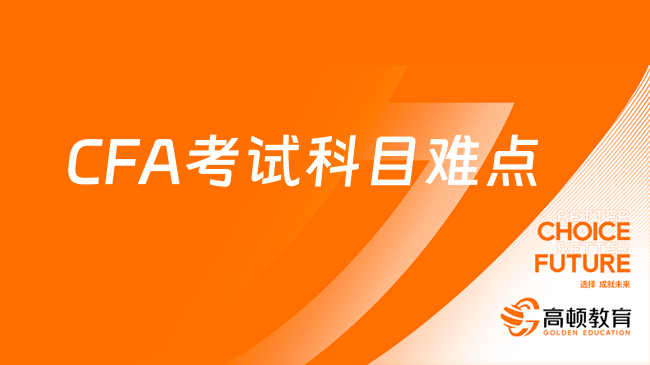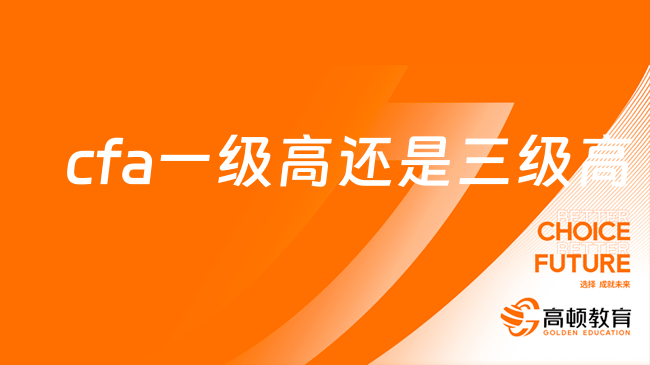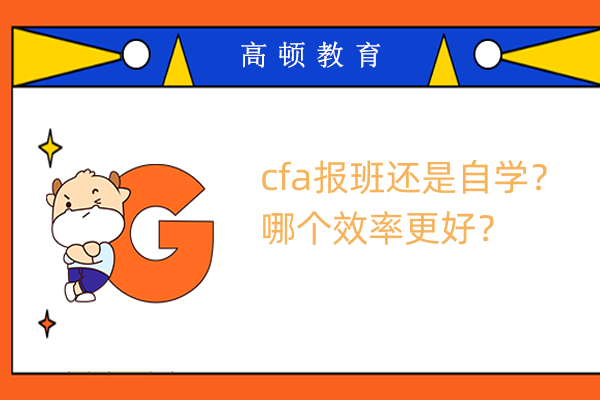这些CFA历年考试模拟题碾压到你的智商了吗?
CFA一级试题:
1. Beth Knight, CFA, and David Royal, CFA, are independently analyzing the value of Bishop, Inc. stock. Bishop paid a dividend of $1 last year. Knight expects the dividend to grow by 10% in each of the next three years, after which it will grow at a constant rate of 4% per year. Royal also expects a temporary growth rate of 10% followed by a constant growth rate of 4%, but he expects the supernormal growth to last for only two years. Knight estimates that the required return on Bishop stock is 9%, but Royal believes the required return is 10%. Royal’s valuation of Bishop stock is approximately:
A. $5 less than Knight’s valuation
B. Equal to Knights valuation
C. $5 greater than Knights valuation
卡普兰教授:Tim Smaby 解析:
The correct answer is A.
You can select the correct answer without calculating the share values. Royal is using a shorter period of supernormal growth and a higher required rate of return on the stock. Both of these factors will contribute to a lower value using the multistage DDM.
Screen Shot 2015-05-22 at 11.36.52
Royal’s valuation is $5.10 less that Knight’s valuation.”
2. John Gray, CFA and Sally Miller are discussing what they think their year-end bonus will be and how they might spend them. Miller is new to working in finance and asks Gray what people usually get and what he has got in the past. Gray explains that the firm prohibits employees from discussing their exact bonus number but also says that 30% of people get ‘good’ bonus’, 50% ‘average’ and 20% ‘low’. Gray says that he really wants a new smart watch recently released by a large tech company and says that he will definitely buy it if he gets a ‘good’ bonus, while there is only a 50% and 10% probability he will get it with an ‘average’ or ‘low’ bonus respectively.
Two weeks later, Miller sees Gray in the office and asks him if he got a good bonus. Gray reminds Miller that the firm’s policy means he cannot say, but Miller notices that he is wearing the new smart watch they were talking about. Miller goes back to her desk and calculates the probability that Gray got a ‘good’ bonus is closest to:
A: 30%
B: 53%
C: 57%
知名投行培训主管Nicholas Blain 解析:
“Using Bayes’ Formula : P(Event|Information) = P(Event) * P(Information |Event) / P(Information)
In this case, the event is getting a good bonus, and the information is that Gray has bought the new watch.
The probability that he got a good bonus and then bought the watch is given by:
P(Event)*P(Information |Event) = 0.3*1.00 = 0.30
The total probability that he would buy the watch is given by:
P(Information) = 0.3*1.00 + 0.5*0.50 + 0.2*0.10 = 0.57
Therefore, the probability that he got a good bonus is the proportion of probability that he got a good bonus and got the watch, to the total probability he got the watch:
P(Event|Information) = 0.30 / 0.57 = 0.53.”
3. For a European Call option on a stock, which of the following changes, (looking at each change individually and keeping all other factors constant) would an analyst be least likely confident about an up or down movement in the price of the option?
A: Share price goes up; dividend goes up
B: The demand for share increases / supply decreases; interest rates fall
C: Share increases in volatility; the firm cancels the next dividend
知名投行培训主管Nicholas Blain 解析:
“Share price up = Option Price Up
Dividend up = Option Price Down (dividends are benefits of holding the underlying share, when holding the option, you do not receive dividend)
Share in High Demand = Option Price down as this is a benefit in holding the underlying
Interest Rates Fall = Option Price Down as this reduces the cost of carry of holding the underlying
Share increases in volatility = Option Price Up
Cancels next dividend = Option Price Up, as these dividends are not received by the option holder anyway
A is the correct answer; as the increase in the option price due to the share going up could be offset by the decrease in the price due to the dividend going up.
B results in the option price falling for both scenarios and C results in the option price rising in both scenarios.”
CFA二级试题:
4. Sudbury Industries expects FCFF in the coming year of 400 million Canadian dollars ($), and expects FCFF to grow forever at a rate of 3 percent. The company maintains an all-equity capital structure, and Sudbury’s required rate of return on equity is 8 percent.
Sudbury Industries has 100 million outstanding common shares. Sudbury’s common shares are currently trading in the market for $80 per share.
Using the Constant-Growth FCFF Valuation Model, Sudbury’s stock is:
A. Fairly-valued.
B. Over-valued
C. Under-Valued
卡普兰教授:Tim Smaby 解析:
“The correct answer is A.
Based on a free cash flow valuation model, Sudbury Industries shares appear to be fairly valued.
Since Sudbury is an all-equity firm, WACC is the same as the required return on equity of 8%.
The firm value of Sudbury Industries is the present value of FCFF discounted by using WACC. Since FCFF should grow at a constant 3 percent rate, the result is:
Firm value = FCFF1 / WACC?g = 400 million / 0.08?0.03 = 400 million / 0.05 = $8,000 million
Since the firm has no debt, equity value is equal to the value of the firm. Dividing the $8,000 million equity value by the number of outstanding shares gives the estimated value per share:
V0 = $8,000 million / 100 million shares = $80.00 per share
5. Excerpt from item set
Financial information on a company has just been published including the following:
Net income $240 million
Cost of equity 12%
Dividend payout rate (paid at year end) 60%
Common stock shares in issue 20 million
Dividends and free cash flows will increase a growth rate that steadily drops from 14% to 5% over the next four years, then will increase at 5% thereafter.
The intrinsic value per share using dividend-based valuation techniques is closest to:
A. $121
B. $127
C. $145
高顿财经研究院主任 Feng 解析:
“The H-model is frequently required in Level II item sets on dividend or free cash flow valuation.
The model itself can be written as V0 = D0 ÷ (r – gL) x [(1 + gL) + (H x (gS – gL))] where gS and gL are the short-term and long-term growth rates respectively, and H is the “half life” of the drop in growth.
For this question, the calculation is: dividend D0 = $240m x 0.6 ÷ 20m = $7.20 per share.
V0 = $7.20 ÷ (0.12 – 0.05) x [1.05 + 2 x (0.14 – 0.05)] = $126.51, answer B.
However, there is a neat shortcut for remembering the formula. Sketch a graph of the growth rate against time: a line decreasing from short-term gS down to long-term gL over 2H years, then horizontal at level gL. Consider the area under the graph in two parts: the ‘constant growth’ part, and the triangle.
If you look at the formula, the ‘constant growth’ component uses the first part of the square bracket, i.e. D0 ÷ (r – gL) x [(1 + gL) …], which is your familiar D1 ÷ (r – gL). For the triangle, what is its area? Half base x height = 0.5 x 2H x (gS – gL) = H x (gS – gL). This is the second part of the square bracket.
Hence the H-model can be rewritten as V0 = D0 ÷ (r – gL) x [(1 + gL) + triangle].”
CFA三级试题:
6.A German portfolio manager entered a 3-month forward contract with a U.S. bank to deliver $10,000,000 for euros at a forward rate of ?0.8135/$. One month into the contract, the spot rate is ?0.8170/$, the euro rate is 3.5%, and the U.S. rate is 4.0%. Determine the value and direction of any credit risk.
卡普兰教授:Tim Smaby 解析:
“The German manager (short position) has contracted with a U.S. bank to sell dollars at ?0.8135, and the dollar has strengthened to ?0.8170. The manager would be better off in the spot market than under the contract, so the bank faces the credit risk (the manager could default). From the perspective of the U.S. bank (the long position), the amount of the credit risk is:
Vbank (long) = ?8,170,000 / (1.04)2/12 ? ?8,135,000 / (1.035)2/12 = ?28,278
(The positive sign indicates the bank faces the credit risk that the German manager might default.)”
7. Within the ‘Option Strategies’ section
Option Strike Premium
Call 1X1 = 20 c1 = 6
Call 2X2 = 30 c2 = 4
Put 1X1 = 20 p1 = 0.604
Put 2X2 = 30 p2 = 8.001
Risk-free rate continuously compounded: 4% annual
Option expiry: 6 months
Using the above data for a box spread, calculate what arbitrage profit can be achieved at the end of 6 months.
高顿财经研究院主任 Feng 解析:
“First, work out the cost of the box spread. Combine the two call options into a bull spread (buy the low strike call and sell the high strike call), and the two put options into a bear spread (buy the high strike put and sell the low strike put). Combining those two gives a box spread. To calculate the initial cost, work out the net premia:
Cost = c1 – c2 + p2 – p1 = 6 – 4 + 8.001 – 0.604 = $9.397
The payoff from the box spread will be the difference between the strike levels, ie 30 – 20 = $10.
If you borrowed $9.397 at the beginning in order to enter the box spread, how much would you have to pay back after 6 months? You need to compound the cost at the risk-free rate:
$9.397 x e0.04 x 0.5 = $9.58683
So the arbitrage profit would be the difference between the payoff and what you have to pay back on the loan, ie $10 – $9.58683 = $0.41317”
8. Assume Felix Burrow is a US investor, holding some euro-denominated assets. Given the information below, calculate the domestic return for Burrow over the year.
Today Expected in 1 year
Euro asset 201.54 203.12
USD/EUR exchange rate 1.1133 1.1424
知名投行培训主管Nicholas Blain 解析:
“The domestic return (return in USD terms) depends on the EUR-return of the asset, as well as on the change in exchange rates:
RDC = (1+RFC) (1+RFX) -1
where RFX is the change in spot rates, using the domestic currency as the price currency (ie we require a USD/EUR quote). In this example, the exchange rate is quoted as such, so we can use the quote provided (otherwise, if the domestic currency was the base currency, we would need to invert the quote first).
RFC = -1 = 0.0078 = 0.78%
RFX = -1 = 0.0261 = 2.61%
RDC = (1 + 0.78%)(1 + 2.61%) – 1 = 3.41%
Burrow’s domestic currency return was higher than the underlying asset return, because he further benefits from the appreciation of the Euro (depreciation of the USD).”
最后,高顿网校小编预祝各位CFA考生都能顺利通过CFA考试~
【超详细保姆教程】CFA考试真题
真题高频考点,刷题全靠这份资料
CFA报考指南
梳理核心考点,一图看懂全部章节
CFA-L1-考纲-2023
全科备考学习打卡表,备考按照计划走
- cfa证书就业岗位有哪些?
-
cfa考完后可以从事的工作包括公司会计、基金经理助理、投资管理师、股票研究分析师、基金分析师、投资产品分析师、券商助理分析师、交易员等。在全球范围内,cfa会员的雇主包括了摩根大通、汇丰银行等机构。
- cfa考试内容有哪些?
-
cfa考试分为三个等级,cfa一级和二级考试科目包括《职业伦理道德》、《定量分析》、《经济学》、《财务报表分析》、《公司理财》、《投资组合管理》、《权益投资》、《固定收益投资》、《衍生品投资》、《其他类投资》。cfa三级考试科目包括《经济学》、《投资组合管理》、《权益投资》、《职业伦理道德》、《固定收益投资》、《其他类投资》、《衍生工具》。
- cfa一年考几次?
-
cfa每年考试的次数每个级别均有不同,其中CFA一级考试每年设置四次,CFA二级考试每年设置三次,CFA三级考试每年设置两次。需注意,协会规定考生必须要按照CFA考试的三个级别,依次进行报考,且报考两个级别考试的窗口之前需至少间隔6个月。
- cfa的含金量如何?
-
CFA证书全称Chartered Financial Analyst(特许注册金融分析师),是全球投资业里最为严格与高含金量资格认证,为全球投资业在道德操守、专业标准及知识体系等方面设立了规范与标准,具有较高的知名度和影响力。 英国的国际学术认证中心,还将持有CFA证书视为拥有硕士学历水平,能让想进修的金融专业人士,充分学习等同于金融硕士的知识课程。此外,人民日报三年内连续四次推荐CFA证书!因此,无论是从国际知名度还是国内知名度来说,CFA资格认证的含金量和认可度都是非常高的。
-
2024年CFA一二三级考试流程全曝光,附详细介绍! 2023-09-28
-
CFA视频课程及CFA一、二、三级课程内容解读 2023-09-01
-
2024年CFA考生该如何选用cfa备考教材?点击查看 2023-08-27
-
即将开考:cfa这些考试技巧请码住 2023-08-16
-
CFA怎么学效果才最好?看看学霸是怎么做的 2023-08-15
-
CFA考试科目难点有哪些,需要注意那几个方面? 2023-08-10
-
热门问题解答!CFA官网的教材费可以退吗? 2023-08-07
-
热门问题解答:学完金融分析师以后能干嘛? 2023-08-01
-
CFA考试科目能搭配学习吗?CFA复习计划该如何制定呢? 2023-07-19
-
可以跨专业考CFA吗?CFA应该如何去备考这点你得知道! 2023-07-19
-
cfa证书每年会员费用多少钱?看完这篇就够了 2023-07-19
-
成都cfa二级题型是什么样的?2024年考生必看 2023-07-18
-
cfa培训班一般都是多少钱?收费标准是什么样的? 2023-07-12
-
零基础报班考cfa需要学习多久?干货速收藏! 2023-07-10
-
零基础报班考cfa需要学习多久?干货速收藏! 2023-07-10
-
cfa道德怎么学效果才最好?你需要知道! 2023-07-05
-
cfa一级高还是三级高?点击查看详情! 2023-07-04
-
学CFA有哪些注意事项?看这一篇就够了 2023-06-29
-
cfa学习用什么书,看完这篇你就知道答案了! 2023-06-19
-
cfa基础知识总记不住怎么办?教你几个小妙招! 2023-06-19
-
cfa要学哪些课程?看完这篇你就明白了 2023-06-16
-
cfa报班还是自学?哪个效率更好? 2023-06-15
-
cfa学习规划应该是什么样的,该如何制定? 2023-06-15
-
cfa学习资料有哪些,学习资料在哪里获取? 2023-06-15
-
cfa英语不好的怎么学?考生如何提高自身英语水平? 2023-06-15
-
CFA道德需要用什么资料?如何复习CFA道德科目? 2023-06-15
-
cfa学习计划如何制定?备考cfa到底有多难? 2023-06-14
-
cfa学习资料一共有哪些,怎么才能获取这些资料? 2023-06-14
-
cfa证书难考吗,如何攻克这些难点? 2023-06-06
 更多服务
更多服务








































